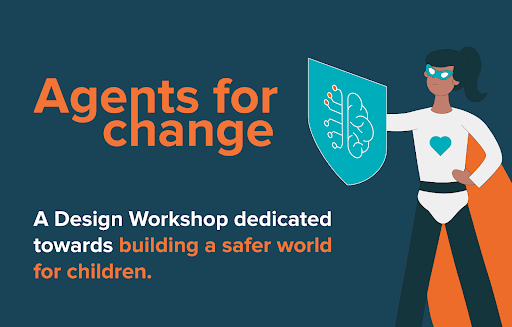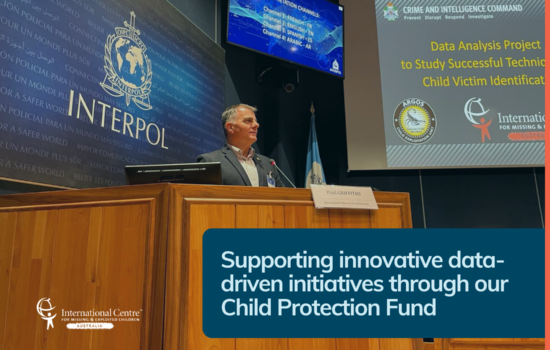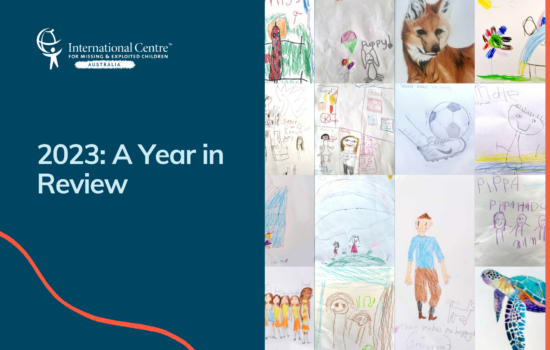Bringing Together a Network to Solve a Network Problem

Do we know who our kids are talking to online and what they are sharing?
How might we anticipate and respond to the scale and speed of changing offender behaviour in the child sexual exploitation space?
What do those organisations working on the response to CSE need or want to help increase effectiveness?
These are just three of the questions that drove rigorous debates and discussions at our first ICMEC and Tobias hosted Design Studio workshop, which invited those working at the front line of child sexual exploitation (CSE) to consider how it could be prevented and disrupted. Under the banner of ‘Agents for Change’, 51 CSE disruption ecosystem players from the fields of law enforcement, finance, data science, machine learning, social impact, criminology, cyber crime and regulation came together for one full day of immersion in the problem space and a series of ideation sessions.
It takes a network to solve a network problem.
Child sexual exploitation is a huge, global crime that is growing at double to triple digit rates (depending on the measure used), and at a scale and volume (e.g. one million known web addresses with child sexual abuse material) that no one regulator, law enforcement agency, school or NGO alone can keep up with. This was one of the systemic ‘gaps’ that the Tobias strategic design team identified while conducting a user centred research study into the CSE response ecosystem for ICMEC Australia. While perpetrators of online child exploitation may be well connected on dark websites and chat rooms where they can share information with the goal of avoiding detection, our ecosystem stakeholders are often working in silos. This means that sometimes they are unable to leverage the intelligence, information and tools that exist across the ecosystem collectively. The goal of the Design Studio was to find out what roles the players currently play and could play in the future, building on the Tobias research that mapped the ecosystem and the gaps in the ecosystem for ICMEC Australia.
The need for action was brought to life by keynote speakers Simon Nasht and Steve Taylor who shared their stories and thoughts on combating CSE. Simon is one of Australia’s most experienced documentary filmmakers, and the producer of The Children in the Pictures; Steve is a 17 year veteran of the Queensland Police Service and currently a detective senior constable at Argos, the Queensland Police Service’s specialist unit investigating online child sexual exploitation. Prosecution of offenders and seizing child sexual abuse material is critical as this can put a stop to re-victimisation of the victims; while preventing child sexual exploitation from happening in the first place should also be part of the disruption strategy.
The participants at the Design Studio worked in multi-disciplinary teams to explore, debate, steal, challenge, unpack and build on each other’s ideas with varying points of CSE disruption, by the end of the day producing and presenting 20 group ideas and 100+ individual solution ideas that we can now move forward with. Some of these ideas may be solved through new innovative technology, some of them through new collaboration programs, and some of them through the recently established Child Protection Fund. There is no doubt the right physical environment boosts creativity and offers the ‘permission’ for all personalities to put forward and explore ideas, big picture and detailed, immediate and long term. We were very grateful to have the support of Canva for providing their wonderful space and catering services by their social enterprise partners. The participants were able to immerse themselves in the three large scale maps on the walls and tables spread across the creative, post-industrial space: current state journey map, ecosystem map and the ‘gaps’ map. During breaks the Design Studio participants networked across sectors, learning from other CSE disruptors while enjoying the meals and snacks. At work on the team tables, they drew up ideas at their tables, presented from the front of the room, listened to the innovative concepts with a sense of mission and debated ideas with rigour and hope of ending CSE.
The Design Studio was a key step in our work at ICMEC Australia towards the disruption of crimes against children. We now know where some of the gaps are at the systemic, industry and organisational levels and will continue to create, test and support innovative solutions to assist those responding to this crime.. Do join us to learn about what you can do to help make a safer world for children.
To stay updated on ICMEC’s projects, programs, research and insights please sign up here.



